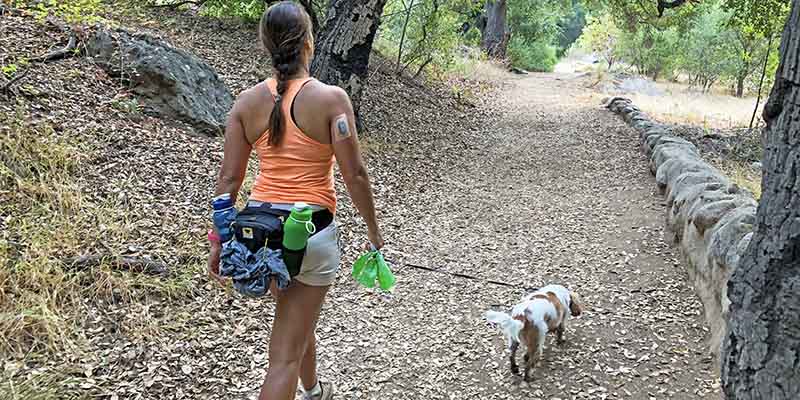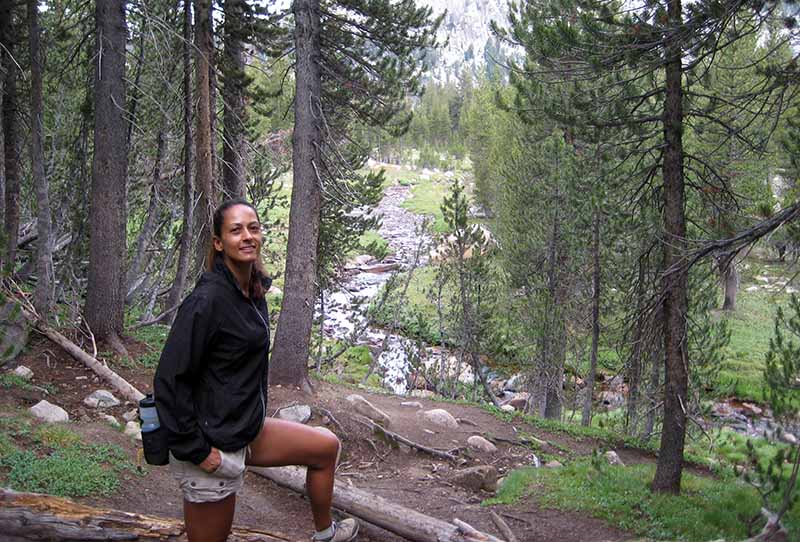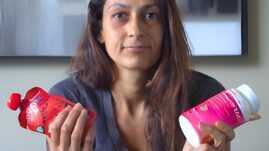One of the things I love most about living in Southern California is that I can be outside wearing shorts pretty much every day of the year. It’s like summer year round and I take full advantage of it by hiking a lot.
Hiking with diabetes is very doable if you prepare well, bring your diabetes gear, and have a good routine for testing and adjusting your blood sugar before, during, and after the hike. I have it down to a science by now, and I always follow the three steps below.
Research the hike
I always look up a new hike to find out how long it is and if it includes any elevations. There are plenty of resources online on where to find good trails, their conditions, length, and elevation.
We usually don’t want to hike more than 2 hours and prefer there to be no crazy elevations (except when we go to places like Yosemite or Hawaii). If the hike is more challenging than our normal hikes, I need to adjust my insulin accordingly and bring extra snacks.
Pack what’s needed
I have a cool fanny pack that I always bring along on hikes. It was originally a gift from me to my husband, and I guess it came with a transport mule = me 😀
I always bring:
- Diabetes gear – My glucose meter (Roche Accu-Chek), my CGM receiver (Dexcom G6) and my insulin pen (InPen)
- Emergency gear – Glucose tablets, fruit strips and perhaps a glucagon emergency kit, such as Baqsimi, Gvoke or Lilly Glucagon
- Water – Minimum 1 liter
- Snacks – Depending on how long we’ll be gone, I might bring a full lunch (like a chicken wrap) or just a few rice cakes or a quest bar.
- Other stuff – Phone, band-aids, sunscreen, etc.
Adjust blood sugar levels and insulin
This is also a 3-step process (I turn everything into 3-step processes if I can. It makes it so much easier to remember):
Measuring and adjusting my insulin before leaving home. If we leave right after a meal and I expect to hit the trail within 2 hours of eating, I’ll reduce my bolus insulin by 25-50% for that meal.
Measuring and potentially adjusting when we get to the hike. I always test my blood sugar level before we start the hike. As with other cardio activities, I know that I need to be careful not to have too much active insulin on board or my blood sugars may go low during the hike. However, if I’m trending above 170 mg/dL (9.4 mmol/L) and have less than ½ unit active insulin on board, I’ll usually adjust with ½-1 unit of insulin.
IMPORTANT: This is what works for me! You need to find the levels that work for you.
If my sugars are in the 90-170 mg/dL (5-9.4 mmol/L) range, I’m usually good. If they are below that, I’ll munch on a rice cake (easy portable 7 g of carb) before starting the hike.
Measure during and after the hike. I rely on my CGM while on the hike but also test occasionally. If the hike includes very steep inclines, I’ll even include that in my calculation for insulin dosage for the rest of the day/night and potentially reduce my night basal insulin.
When you walk up and down a steep elevation, you activate pretty much all the large muscle groups in your legs and that can impact your blood sugars for several hours after you complete your hike. So remember to test your blood sugar more frequently for the rest of the day if you’re new to hiking with diabetes.
Get out there and enjoy nature
There are so many great places to explore in this world of ours and there’s no way my diabetes is going to stand in my way, and it shouldn’t stand in yours either. If you plan ahead and bring all the right gear, hiking with diabetes can be done in a safe manner.
Hiking is both great exercise and a way to be social. If you don’t have a hiking partner, there are plenty of hiking MeetUp groups online or you can try contacting your local ADA or JDRF chapter to find others with diabetes to hike with.
Suggested next posts:
- Symptoms of Low Blood Sugar (Hypoglycemia)
- Nuts and Diabetes: Are Nuts a Good Snack for People with Diabetes?
If you found this guide to hiking with diabetes useful, please sign up for our newsletter (and get a free chapter from the Fit With Diabetes eBook) using the form below. We send out a weekly newsletter with the latest posts and recipes from Diabetes Strong.







Pat Shermer
Great article, my friend sent to me. I’m a hiker and still hiking at 77 years of age. Live in western SD where there are lots of wonderful hiking trails, most of which are climbs. I use an insulin pump so it easy to set back basal. Always take plenty of snacks, mainly granola bars and lunch if I’m hiking during that time. I have a CGM which greatly helps. Living with Type 1 for nearly 60 years and doing well.
Jen
I’m only at 40 years T1… I love hiking, have been skiing it often this season, and I love inclines. Your post is inspiring to me. Onward!
Holly Peterson
I used all your suggestions successfully when I hiked five days on the Chilkoot Trail (Alaska to Canada) a few years ago. Back then I did not have a CGM so used an extra supply of test strips! My CGM would have been a great asset on that trip, but it can still be done without one. Thanks for encouraging all to enjoy the great outdoors!
Christel Oerum
Love to hear that! That sounds like a great adventure
Petrina
Love this article. Thank you so much for the tip. My husband and I hit the bike trails on the weekend , and you wrote about some very important tips I didn’t think about .
Ruth
Thanks for the info. I’m usually ok hiking, but still trying to figure out cycling as I always go low. I carry apple juice and cheese crackers and decrease my bolus a little because I usually go right after breakfast. Still tweaking. Do you have any tips for traveling with insulin when you have to take an extra pen because you’re going to be gone over a month. I have a frio for the current pen if I need it but the next pen should be at refrigerator temp and I don’t know how to do that . Thanks!
Christel Oerum
Hi Ruth,
The frio should be fine, just don’t leave it in a hot car or our in the sun. I often just store my extra insulin with food in an isolated lunchbox including a small cooling block and pop it back in a fridge when I get to my destination. If you don’t have a fridge where you’re going you could use any sort of isolated container. Back when I backpacked (a loong time ago) I had my pens in coffee thermos (without the coffee)
Jen
Ruth, at any hotel, ask for a small fridge for medication. They can’t charge you (they often do for people who want it just for convenience, beer, etc). But keep the insulin LOW away from the freeze/ cold element (usually at the top of the fridge. BEWARE – turn them into a fairly LOW COLD, as if you turn it up too much they can freeze your insulin.
aizad
Hi christel, I am Aizad from malaysia.
thanks for the info. I am diabetic type 1 and with new hobby, hiking.
Christel Oerum
Glad you found it helpful
Linda devereux
I wear a pump and CGM. I turn my basal on the pump down both 30 min before and during the hike, at least by 50% or else I’ll bottom out for sure. During hiking I only bolus 50% for my snacks. Good luck!’
Christel Oerum
I”m so glad you found what works for you! My experience is also that starting the reduction prior to the activity is optimal.
Dorothy
Do you lower your basal insulin while hiking, too? Or just reduce what you take for food and corrections?
Christel Oerum
Hi Dorothy – I’m MDI, not pumping at this time, so it’s not possible for me to reduce my basal during the hike, so yes it’s all about the bolus. Since I’m currently doing resistance training and cardio 5-6 times weekly my basal insulin is already dialed waaaay down to accommodate for that.
Hope that helps,
Christel
Melissa
Great post! Thanks a lot for sharing your experience. I love hiking but I am always a little nervous about managing my blood sugar. I will definitely follow your steps next time 🙂
Christel Oerum
Thank you Melissa. Hiking is amazing so definitely get out there 🙂